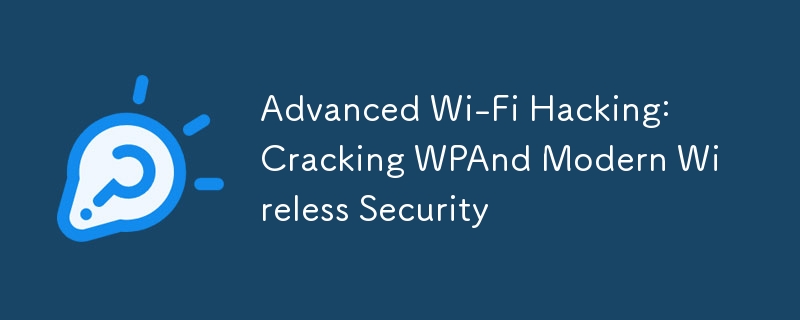
Author: Trix Cyrus
Waymap Pentesting tool: Click Here
TrixSec Github: Click Here
TrixSec Telegram: Click Here
Wireless networks are the backbone of modern connectivity, offering convenience but also exposing vulnerabilities. With WPA3 emerging as the successor to WPA2, it promises enhanced security features. However, no system is entirely impervious to attacks. This article explores advanced Wi-Fi hacking techniques and the security mechanisms of WPA3 while emphasizing the importance of ethical hacking to strengthen wireless security.
Understanding Wi-Fi Security Protocols
Wi-Fi networks have evolved to combat increasing threats. Here’s a quick breakdown of the major security protocols:
-
WEP (Wired Equivalent Privacy): The earliest Wi-Fi security protocol, now obsolete due to severe vulnerabilities.
-
WPA (Wi-Fi Protected Access): Improved encryption but susceptible to brute-force attacks.
-
WPA2: Introduced AES encryption and CCMP for enhanced security. However, it is still vulnerable to KRACK attacks and dictionary attacks.
-
WPA3: The latest standard, offering protections like Simultaneous Authentication of Equals (SAE) and forward secrecy. While much stronger, it’s not entirely bulletproof.
WPA3: What Makes It Secure?
WPA3 includes the following enhancements:
-
Simultaneous Authentication of Equals (SAE): Replaces the PSK (Pre-Shared Key) authentication used in WPA2, providing protection against offline brute-force attacks.
-
Forward Secrecy: Ensures that even if a session key is compromised, previous communications remain secure.
-
192-bit Security Suite: For enterprise-grade networks, adding an extra layer of encryption.
-
Protected Management Frames (PMF): Prevents deauthentication attacks.
Hacking WPA3: Is It Possible?
While WPA3 is significantly more secure than its predecessors, researchers have found vulnerabilities:
-
Dragonblood Attacks: These exploit flaws in WPA3’s SAE handshake, allowing attackers to recover passwords or launch side-channel attacks.
-
Downgrade Attacks: Some routers support WPA2/WPA3 mixed modes, enabling attackers to force connections to the less secure WPA2 protocol.
-
Implementation Flaws: Poorly configured or outdated devices can still expose networks to vulnerabilities.
Tools for Wi-Fi Hacking
Several tools are used by ethical hackers to test Wi-Fi security:
-
Aircrack-ng: A suite for packet capturing, WEP/WPA2 key cracking, and network analysis.
-
Wireshark: A packet analyzer for intercepting and dissecting network communications.
-
Hashcat: A powerful password-cracking tool.
-
Bettercap: A network attack and monitoring tool.
-
HCXTools: Specialized tools for WPA3 SAE attacks.
Ethical Hacking Process: Testing Wi-Fi Security
1. Reconnaissance
Use tools like airodump-ng to identify nearby Wi-Fi networks and gather information, such as:
- SSID (network name)
- BSSID (MAC address of the access point)
- Channel and encryption type
2. Packet Capturing
- Capture packets using airodump-ng or similar tools.
- Look for handshakes in WPA2 or SAE authentication in WPA3.
3. Handshake Analysis
- For WPA2: Use tools like aircrack-ng or Hashcat to brute-force the handshake.
- For WPA3: Attempt Dragonblood attacks or downgrade to WPA2 for exploitation.
4. Brute-Force or Dictionary Attacks
Use a pre-generated wordlist or tools like Crunch to guess passwords.
5. Testing for Configuration Flaws
- Exploit mixed WPA2/WPA3 modes.
- Check for vulnerable devices using outdated firmware.
Protecting Against Wi-Fi Hacking
-
Use WPA3-Only Mode: Disable compatibility modes that allow WPA2 connections.
-
Update Firmware Regularly: Keep your router and devices up-to-date with the latest security patches.
-
Strong Passwords: Use complex, random passwords to defend against brute-force attacks.
-
Disable WPS (Wi-Fi Protected Setup): This feature is vulnerable to brute-force attacks.
-
Network Monitoring: Use tools like Wireshark to monitor traffic and detect anomalies.
-
Enable PMF (Protected Management Frames): Prevent deauthentication attacks.
-
Segment Networks: Use VLANs to isolate critical systems from guest networks.
Ethical Hacking and Legal Considerations
It’s crucial to conduct Wi-Fi security testing ethically:
-
Get Written Consent: Testing Wi-Fi networks without explicit permission is illegal and unethical.
-
Use a Test Environment: Set up a dedicated lab or use your own network to practice and test.
-
Follow Laws and Regulations: Stay within the bounds of local laws and ethical guidelines.
Conclusion
While WPA3 has significantly improved Wi-Fi security, no system is invulnerable. Ethical hacking plays a vital role in identifying and addressing flaws in wireless networks. By understanding advanced Wi-Fi hacking techniques, security researchers and IT professionals can better protect networks and mitigate potential risks.
Always remember: ethical hacking is about protecting, not exploiting. Use your skills responsibly to create a safer digital world!
~Trixsec
The above is the detailed content of Advanced Wi-Fi Hacking: Cracking WPAnd Modern Wireless Security. For more information, please follow other related articles on the PHP Chinese website!






